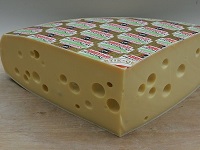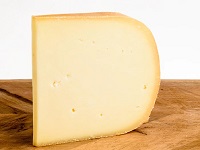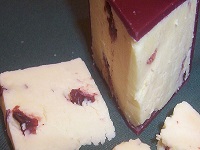Saumur Rouge AOC (France)
Saumur is a French wine region in the Loire Valley.
Saumur Rouge is a red wine made from the grape Cabernet Franc.
Saumur Flavors
Red and Black Berries, and Pyrazine (Jalapeno) are typical Saumur flavors.
Hints of Perfume (Violets), Herbs, Spices, and Gravel or Graphite.
Strawberry |
Raspberry |
Black Cherry |
Blueberry |
Jalapeno |
Herbs |
Violets |
Pepper |
Flavors from Maturation and Aging
Oak |
Mushroom |
Coffee |
Tobacco |
Saumur Profile
Saumur has fine fruit and a dry, fresh, and slightly acidic style:
| SUGAR: | Dry (3 g/l) |
| BODY: | Medium |
| TANNINS: | Medium |
| FRUIT: | Medium |
| ACIDITY: | Medium - High |
| ALCOHOL: | 11.5-13.5% ABV |
| Serving temperature: 14-15°C (57-59°F) | |
Saumur Food Pairing
Saumur is a very versatile food wine. It pairs perfectly with rich Stews, Cassoulets and Marinated Asian (Not Spicy).
Saumur also loves BBQ and Grilled Meat (Beef. Veal. Pork. Chicken. Game).
In addition, the acidic style pairs well with Vinegar and Tomato-based Dishes.
Antipasti |
Olive Oil |
Vinegar |
Soups |
Pasta |
Spaghetti |
Pizza |
Lasagna |
Chicken |
Pork |
Lamb |
Veal |
Excellent Pairings
Rich Pasta. Ravioli.
Lasagna. Spaghetti Meatballs.
Fried or Grilled Mushrooms.
Soups. Casseroles.
Stews. Beef Stew. Veal.
Roasted Chicken, Pork, or Lamb.
BBQ. Grilled Beef.
The Ideal Glass for Saumur
The Bordeaux Glass was designed for enjoying fuller-bodied, tannic red wines.

|
They are taller than other red wine glasses, and has a slimmer bowl.
The slimmer bowl directs the wine to the back of your mouth for a maximum taste. The size also allows the bouquet of the wine to develop, smooth out rough edges, play down tannins, and allow the wine to achieve balance. |
Saumur Cheese Pairing
If You Like Saumur
You Might Also Like:
Cabernet Franc in France
The Loire Valley
The most prestigious Cabernet Franc wines comes from the Loire Valley in France.
Bourgueil, Chinon, and Saumur-Champigny are all made almost exclusively with Cabernet Franc.
These wines are dry, elegant, and medium-bodied red wines with a fine berry-like fruit, often marked by slightly grape stalk tannins in the aftertaste.
In good years, these wines can recall Bordeaux wines.
The Bordeaux Blends
In Bordeaux, Cabernet Franc is used in blends with Cabernet Sauvignon (Left Bank) and Merlot (Right Bank) to make the famous Bordeaux wines.
Cabernet Franc is lighter than Cabernet Sauvignon and adds a pale red color and a peppery perfume to the blend.
Common Uses of Cabernet Franc
As a Blending Grape
In Bordeaux, and in New World blends, Cabernet Franc adds:
- Aromatic complexity
- Herbaceous lift
- Softer tannins
- Earlier ripening (handy in cooler years)
As a Varietal Wine
Especially in:
- Loire Valley
- Argentina
- USA (New York, Washington)
In Rosé Wines
Especially in the Loire and parts of the U.S.
Cabernet Franc contributes with crisp acidity and herbaceous fruit.
About Cabernet Franc
Cabernet Franc is one of the parents of Cabernet Sauvignon (the other is Sauvignon Blanc). It is an older grape variety, and it likely originated in Spanish Basque Country as a cross from 2 local grapes: Morenoa and Hondarribi Beltza.
Even if Cabernet Franc is related to Cabernet Sauvignon it does not have the same qualities. Cabernet Franc is lighter, more fruity, less tannic, and it ripens earlier.
Cabernet Franc creates wines with great fruit aromas (raspberry, strawberry, cherry) and violets, as well as a spicy touch of bell pepper.
Cabernet Franc wines may lack some body, but they have a great aroma. It is often mixed with Merlot or big brother Cabernet Sauvignon, both of which give more fullness to the Cabernet Franc.
DNA
Cabernet Franc originated in Spanish Basque Country from 2 local grapes: Morenoa and Hondarribi Beltza.
It’s known as "Bouchet" in Saint-Émilion, "Bouchy" in the Pyrenées, "Breton" in the Loire Valley and Alcheria (Fox) in the Basque Country.
Terroir
Cabernet Franc is a worl-wide grape because it adapts to different terroirs, often the same terroirs as Cabernet Sauvignon.
Cabernet Franc loves sand, gravel, limestone, and clay.
The better performance in the world is in Saint-Émilion (Bordeaux), in the Loire Valley and in Italy (Tuscany and Friuli).
Wine Region Loire


Loire Valley Climate
Different regions are subject to different climate influences:
Lower Loire (Muscadet and Pays Nantais) has a cool maritime climate with high rainfall.
Middle Loire (Anjou-Saumur and Touraine) has a cold climate with a mix of oceanic and continental influence.
Central Loire (Sancerre and Pouilly-Fumé) has a cold continental climate with cold winters and warm summers.
Loire Valley Terroir
The terroir in the Loire Valley is incredibly varied due to its geographic spread:
Lower Loire is known for its granite and schist soils, which give the wines (Muscadet) a distinctive mineral character.
Middle Loire has limestone, clay and sand soils. The Saumur and Touraine soils can be good for both white and red wines.
Central Loire has limestone and silex (flint) soils which give the Sancerre and Pouilly-Fumé wines their signature smoky and mineral flavors.
65% White Grapes
30% Chenin Blanc |
35% Black Grapes
20% Cabernet Franc |
45% White Wines
Anjou Blanc |
20% Red Wines
|
20% Rosé Wines
|
15% Sparkling Wines
|










